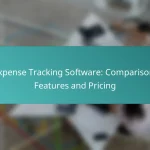What are the best corporate expense management solutions in the US?
The best corporate expense management solutions in the US streamline the process of tracking and managing employee expenses while ensuring compliance with company policies. These solutions often include automated reporting, real-time tracking, and integration with existing financial systems.
Automated expense reporting software
Automated expense reporting software simplifies the submission and approval process for employee expenses. Employees can easily upload receipts and categorize expenses, while managers can review and approve submissions quickly. This reduces manual entry errors and speeds up reimbursement times.
When selecting software, consider features like mobile access, integration capabilities, and user-friendliness. Popular options include Expensify and Concur, which are designed to cater to various business sizes.
Real-time expense tracking apps
Real-time expense tracking apps allow companies to monitor spending as it occurs, providing immediate insights into budget adherence. Employees can log expenses on-the-go, and managers can receive instant notifications for approvals or budget overruns.
Look for apps that offer features such as GPS tracking for travel expenses and integration with accounting software. Examples include Zoho Expense and Rydoo, which help maintain financial control and transparency.
Cloud-based financial management platforms
Cloud-based financial management platforms centralize all financial data, including expenses, in one accessible location. These platforms enable businesses to generate reports, analyze spending patterns, and forecast future expenses effectively.
Key considerations include data security, scalability, and the ability to integrate with other financial tools. Popular platforms like QuickBooks Online and Xero provide comprehensive solutions for managing corporate finances.
Corporate credit card integration
Integrating corporate credit cards with expense management systems simplifies the tracking of employee spending. Transactions are automatically imported, reducing the need for manual entry and improving accuracy in expense reporting.
When choosing a solution, ensure it supports multiple card types and offers features like spending limits and transaction categorization. Companies often use cards from providers like American Express or Visa that offer integration with popular expense management software.
Expense policy enforcement tools
Expense policy enforcement tools help ensure that employee spending aligns with company guidelines. These tools can flag non-compliant expenses and provide reminders about policy limits during the submission process.
Implementing such tools can reduce unauthorized spending and promote accountability. Look for solutions that offer customizable policy settings and reporting features to help identify trends in compliance. Examples include Certify and Spendesk, which assist in maintaining financial discipline within organizations.
How can companies mitigate risks in expense management?
Companies can mitigate risks in expense management by implementing structured processes and controls that ensure accountability and compliance. Effective strategies include establishing approval workflows, conducting regular audits, and providing employee training on expense policies.
Implementing strict approval workflows
Strict approval workflows help control spending by requiring multiple levels of authorization for expenses. This process ensures that all expenditures are necessary and align with company policies, reducing the risk of unauthorized spending.
To create an effective approval workflow, companies should define clear thresholds for different expense categories. For example, expenses above a certain amount may require managerial approval, while smaller amounts can be approved by team leads.
Regular audits and compliance checks
Regular audits and compliance checks are essential for identifying discrepancies and ensuring adherence to expense policies. These audits can be conducted quarterly or biannually, depending on the size and complexity of the organization.
During audits, companies should review expense reports, receipts, and approval documentation to verify that expenses are legitimate. Utilizing automated tools can streamline this process and enhance accuracy, making it easier to spot irregularities.
Employee training on expense policies
Training employees on expense policies is crucial for minimizing risks associated with expense management. Employees should understand what constitutes an allowable expense and the process for submitting claims.
Regular training sessions and updates can keep staff informed about any changes to policies. Providing clear documentation and examples of acceptable expenses can further reduce misunderstandings and errors in expense reporting.
What are the key features of effective expense management software?
Effective expense management software typically includes features that streamline expense tracking, enhance visibility, and improve compliance. Key functionalities often encompass mobile access, integration with existing accounting systems, and customizable reporting options.
Mobile accessibility for employees
Mobile accessibility allows employees to submit expenses and track spending directly from their smartphones or tablets. This feature is crucial for enhancing user engagement and ensuring timely submissions, especially for employees who travel frequently.
When selecting software, look for mobile applications that support photo uploads for receipts and real-time notifications for expense approvals. This can significantly reduce the time spent on manual entries and improve accuracy.
Integration with accounting systems
Integration with accounting systems is vital for seamless financial management. Effective expense management software should easily connect with popular accounting platforms like QuickBooks, Xero, or SAP, allowing for automatic data synchronization.
Consider software that offers API access or pre-built connectors to minimize manual data entry and reduce errors. This integration helps maintain accurate financial records and simplifies the reconciliation process.
Customizable reporting capabilities
Customizable reporting capabilities enable organizations to generate tailored reports that meet specific business needs. Users should be able to filter expenses by categories, departments, or timeframes to gain insights into spending patterns.
Look for software that provides easy-to-use reporting tools, allowing users to create visual dashboards and export data in various formats. This flexibility can assist in budget planning and identifying areas for cost savings.
What criteria should businesses consider when choosing expense management tools?
Businesses should evaluate expense management tools based on scalability, user-friendliness, and cost-effectiveness. These criteria ensure that the selected tools can adapt to growth, are easy for employees to use, and provide a good return on investment.
Scalability for future growth
Scalability is crucial as businesses evolve. A suitable expense management tool should accommodate increasing transaction volumes and additional users without significant performance issues. Look for solutions that offer tiered pricing or modular features that can be added as your company expands.
For example, a tool that starts with basic expense tracking but allows for advanced reporting and integration with other financial systems can support your business as it grows. This flexibility helps avoid the need for frequent tool replacements, saving time and resources.
User-friendliness for employees
User-friendliness directly impacts employee adoption and satisfaction. A tool should have an intuitive interface that minimizes the learning curve, allowing employees to submit expenses quickly and accurately. Features like mobile access can enhance convenience, enabling users to capture receipts on the go.
Consider conducting a trial or demo with a small group of employees to gather feedback on usability. Tools that require minimal training and offer clear support resources tend to be more successful in fostering compliance and reducing errors.
Cost-effectiveness and ROI
Cost-effectiveness is vital when selecting expense management tools. Evaluate both the upfront costs and ongoing fees, ensuring they align with your budget. A good tool should not only fit within your financial constraints but also demonstrate a clear return on investment through time savings and reduced errors.
To assess ROI, consider factors like decreased processing time for expense reports and improved accuracy in financial reporting. A tool that saves even a few hours per month can lead to significant savings over time, especially in larger organizations.
What are the common challenges in corporate expense management?
Corporate expense management faces several challenges that can hinder efficiency and accuracy. Key issues include fraudulent claims, lack of visibility into spending, and employee resistance to new systems.
Fraudulent claims and misuse
Fraudulent claims and misuse of funds are significant risks in corporate expense management. Employees may submit false receipts or inflate expenses, leading to financial losses. Companies should implement strict verification processes to mitigate these risks.
To combat fraud, organizations can use automated expense management software that flags unusual spending patterns and requires additional documentation for high-value claims. Regular audits and employee training on ethical spending practices can also help reduce misuse.
Lack of visibility into spending
A lack of visibility into spending can prevent organizations from effectively managing their budgets. Without clear insights, companies may overspend in certain areas while underutilizing resources in others. This can lead to inefficient allocation of funds.
To enhance visibility, businesses should adopt centralized expense tracking systems that provide real-time data on spending. Dashboards and reporting tools can help managers analyze expenses by category, department, or project, enabling informed decision-making.
Employee resistance to new systems
Implementing new expense management systems often meets with employee resistance, which can hinder adoption and effectiveness. Employees may be accustomed to existing processes and reluctant to change, fearing increased workload or complexity.
To ease this transition, organizations should involve employees in the selection process of new systems and provide comprehensive training. Highlighting the benefits, such as time savings and reduced errors, can also encourage acceptance and improve overall compliance with new procedures.
How can companies ensure compliance with expense policies?
Companies can ensure compliance with expense policies by implementing clear guidelines and regular monitoring. Establishing a culture of accountability and providing employees with the necessary training are essential steps in maintaining adherence to these policies.
Regular training sessions for employees
Regular training sessions for employees are vital for reinforcing compliance with expense policies. These sessions should cover the specifics of the policies, including what constitutes allowable expenses and the proper procedures for submitting claims.
Consider scheduling training at least once a year, with additional sessions whenever policies change. Interactive workshops can enhance understanding and retention, allowing employees to ask questions and engage with real-life scenarios.
To maximize effectiveness, include practical examples and case studies in the training. This approach helps employees relate to the material and understand the implications of non-compliance, ultimately fostering a more responsible expense culture within the organization.






